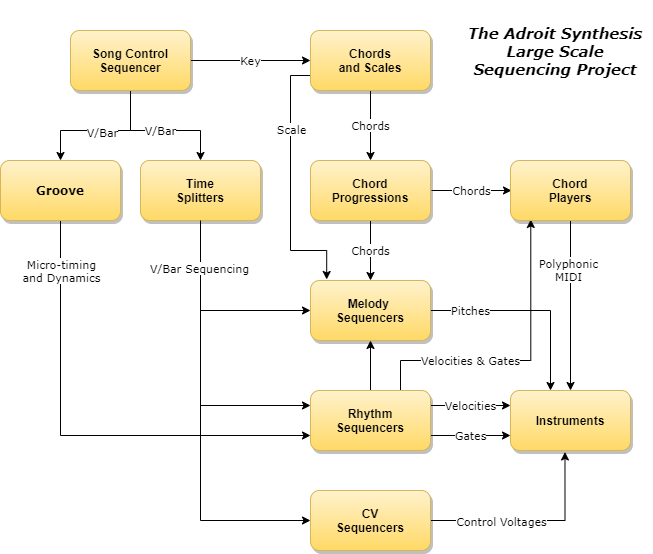LSSP is an abbreviation for the Large Scale Sequencing Project – a collection of Adroit Synthesis modules designed to help you compose music in a modular synthesis environment.
LSSP runs on both Windows and Mac computers but is only available as part of Cherry Audio’s Voltage Modular.
LSSP XL is the entire suite of modules. LSSP 101 is a specially selected subset. The Adroit Toolkit is another subset that focuses on general purpose tools.

Each of the blocks in the diagram above represents one or more modules in a Voltage Modular patch.
This diagram might not make a great deal of sense initially but when you have explored the modules a little it might be worth coming back and looking at it again as it could help you gain a more holistic perspective of the architecture.
One important thing to note is that LSSP generates signals that control other modules and it is these other modules that then generate sounds. LSSP itself doesn’t generally produce any audio signals (although technically some modules are capable of producing or processing audio signals).
LSSP Patches in Practice
In practice the exact form of an LSSP patch depends on what you want to achieve. This open-ended approach is of course the beauty of modular systems.
At one extreme a simple setup might use a subset of the functionality and consist of just a handful of modules that patched together operate like a neat little drum machine or a simple bass line sequencer for instance.
At the opposite extreme, systems that implement entire symphonic scale compositions can be built providing that you have the massive computing power required to use hundreds of modules simultaneously and of course the ingenuity and patience to build such large scale patches.
To jump straight into using LSSP check out the LSSP 101 Tutorials.
If you are interested in finding out more about the reasoning behind LSSP then check out the Design Philosophy page.
LSSP is a large scale and mostly novel architecture. It’s not a collection of run-of-the-mill modules that are very similar to things you might have already encountered. It’s not ridiculously complicated and many elements should feel at least vaguely familiar but it consists of over 50 different modules and is ambitious in scope.
For this reason a subset of LSSP is available called LSSP 101. This is more affordable than LSSP XL and is supported by a series of easy to follow tutorials that introduce various modules and concepts step by step.
If you opt for LSSP XL rather than LSSP 101 then these tutorials are still very valuable, it’s just that they only require the subset of modules provided by LSSP 101 to work.
An automatic discount on LSSP XL will be applied if you have already purchased LSSP 101 or the Adroit Toolkit.
Skins
By default LSSP modules use a background that’s called the “classic” skin…

But many people prefer a plain dark background, so a Skin module is provided that enables you to easily select the background you prefer.
